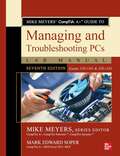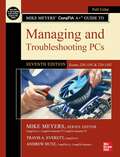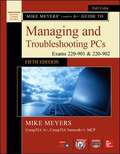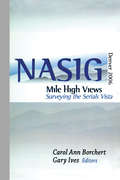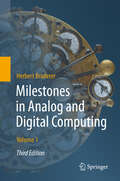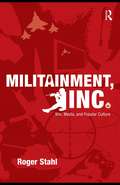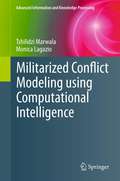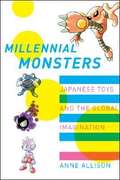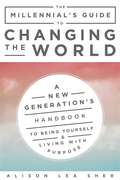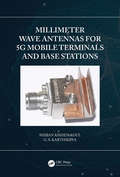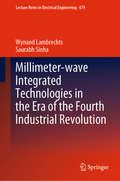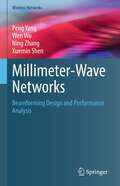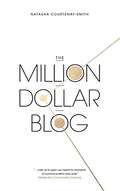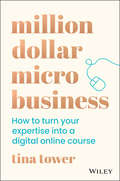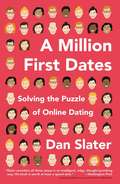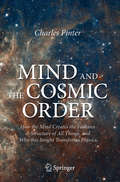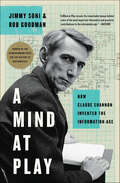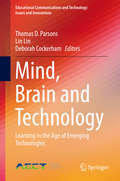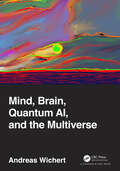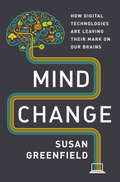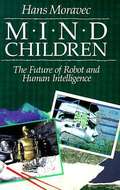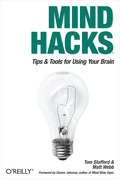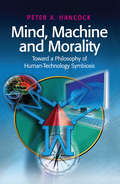- Table View
- List View
Mike Meyers' Comptia A+ Guide To Managing And Troubleshooting Pcs Lab Manual
by Mike Meyers Mark Edward SoperThis practical workbook contains more than 140 labs that challenge you to solve real-world problems by applying key concepts. Thoroughly revised for the 220-1001 and 200-1002 exam objectives, this book maps directly to Mike Meyers’ CompTIA A+® Guide to Managing and Troubleshooting PCs, Sixth Edition. You will get complete materials lists, setup instructions, and start-to-finish lab scenarios. “Hint” and “Warning” icons guide you through tricky situations, and post-lab questions measure your knowledge.
Mike Meyers' Comptia A+ Guide To Managing And Troubleshooting Pcs Lab Manual, Seventh Edition (exams 220-1101 & 220-1102)
by Mike Meyers Mark Edward SoperThis practical workbook contains more than 140 labs that challenge you to solve real-world problems by applying key concepts. Thoroughly revised for the 220-1101 and 220-1102 exam objectives, this book maps directly to Mike Meyers’ CompTIA A+™ Guide to Managing and Troubleshooting PCs, Seventh Edition. You will get complete materials lists, setup instructions, and start-to-finish lab scenarios. “Hint” and “Warning” icons guide you through tricky situations, and post-lab questions measure your knowledge.
Mike Meyers' CompTIA A+ Guide to Managing and Troubleshooting PCs: (Exams 220-1101 & 220-1102)
by Mike Meyers Travis A. Everett Andrew HutzFully Updated, Essential Skills for a Successful IT Career. <p><p>Created and edited by the leading authority on CompTIA A+ certification and training, this four-color guide will help you pass CompTIA A+ exams 220-1101 and 220-1102 and become a certified IT professional with proven expertise in hardware and software. Mike Meyers’ CompTIA A+™ Guide to Managing and Troubleshooting PCs, Seventh Edition offers complete coverage of the latest exam objectives. You’ll get on-the-job tips, end-of-chapter review questions, and hundreds of photographs and illustrations.
Mike Meyers' CompTIA A+ Guide to Managing and Troubleshooting PCs, Fifth Edition (exams 220-901 And 220-902)
by Mike MeyersEssential Skills for a Successful IT Career Written by the leading authority on CompTIA A+ certification and training, this four-color guide will help you become a certified IT professional with proven expertise in hardware and software, and help you pass CompTIA A+ exams 220-901 and 220-902. Mike Meyers' CompTIA A+ Guide to Managing and Troubleshooting PCs, Fifth Edition offers complete coverage of the latest exam objectives. You'll get on-the-job tips, end-of-chapter review questions, and hundreds of color photographs and illustrations. The book also includes a coupon for 10% off of the exam fee--a $37 value. Learn how to: Work with CPUs, RAM, microprocessors, BIOS, motherboards, power supplies, and other PC components Install, configure, and troubleshoot hard drives Manage peripheral devices and removable media Install, upgrade, and maintain operating systems, including Windows, Mac OS X, and Linux Troubleshoot common computer problems Establish users and groups Set up video and multimedia cards Administer smartphones, tablets, and other mobile devices Install and configure wired and wireless networks Connect to the Internet Secure your PC and your network Install, configure, and manage printers and multifunction devices Work with the latest virtualization technologies Understand safety and environmental issues Electronic content includes: Practice exams for 901 & 902 One hour+ of free video training from Mike Meyers TotalSim simulations of performance-based questions Mike's favorite free PC tools and utilities A complete PDF copy of the book Instructor resources available: Instructor's Manual Power Point slides for each chapter with photographs and illustrations from the book Test Bank cartridges with hundreds of questions for use as quizzes and exams Answers to the end of chapter sections are not included in the book and are only available to adopting instructors
Mile-High Views: Surveying the Serials Vista: NASIG 2006
by Carol Ann Borchert Gary IvesDiscover the latest developments in serials publication Current advances in technology and research have triggered accelerating change in the state of serials, which makes keeping up-to-date on developments difficult. Mile-High Views: Surveying the Serials Vista: NASIG 2006 presents the leaders of serials publication providing their perspectives on the state of the world on the future of serials. This compilation includes several superb presentations from the 21st annual North American Serials Interest Group conference held in Denver, Colorado, in May, 2006. Mile-High Views: Surveying the Serials Vista: NASIG 2006 explores serials publication through helpful reviews of cataloging and techniques for implementing various projects. Also included are chapters exploring visions for the future, strategies for practical application of technology and theory, and tactical information to manage employees and economic resources. This book brings readers the world of serials as it is today-and as it will be in the future. Topics in Mile-High Views: Surveying the Serials Vista: NASIG 2006 include: basic and advanced serials cataloging electronic resource license language implementing an institutional repository (IR) impact of digitizing serials in the next ten years details about the success in digitizing Colorado&’s Historic Newspaper Collection evolving roles in the digital communication system review of the various uses of FRBR alternative citation sources beyond the Web blogs, wikis, and podcasts managing personnel resource description and access (RDA) vendor-sponsored training electronic resource management (ERM) systems practices and principles of good project management Open Access publishing collection development print and online journal cost comparisons and more! Mile-High Views: Surveying the Serials Vista: NASIG 2006 is a horizon-expanding collection that is perfect for librarians, publishers, and commercial vendors interested in the future of serials publication.
Milestones in Analog and Digital Computing
by Herbert BrudererThis Third Edition is the first English-language edition of the award-winning Meilensteine der Rechentechnik; illustrated in full color throughout in two volumes. The Third Edition is devoted to both analog and digital computing devices, as well as the world's most magnificient historical automatons and select scientific instruments (employed in astronomy, surveying, time measurement, etc.). It also features detailed instructions for analog and digital mechanical calculating machines and instruments, and is the only such historical book with comprehensive technical glossaries of terms not found in print or in online dictionaries. The book also includes a very extensive bibliography based on the literature of numerous countries around the world.Meticulously researched, the author conducted a worldwide survey of science, technology and art museums with their main holdings of analog and digital calculating and computing machines and devices, historical automatons and selected scientific instruments in order to describe a broad range of masterful technical achievements. Also covering the history of mathematics and computer science, this work documents the cultural heritage of technology as well.
Militainment, Inc.: War, Media, and Popular Culture
by Roger StahlMilitainment, Inc. offers provocative, sometimes disturbing insight into the ways that war is presented and viewed as entertainment—or "militainment"—in contemporary American popular culture. War has been the subject of entertainment for centuries, but Roger Stahl argues that a new interactive mode of militarized entertainment is recruiting its audience as virtual-citizen soldiers. The author examines a wide range of historical and contemporary media examples to demonstrate the ways that war now invites audiences to enter the spectacle as an interactive participant through a variety of channels—from news coverage to online video games to reality television. Simply put, rather than presenting war as something to be watched, the new interactive militainment presents war as something to be played and experienced vicariously. Stahl examines the challenges that this new mode of militarized entertainment poses for democracy, and explores the controversies and resistant practices that it has inspired. This volume is essential reading for anyone interested in the relationship between war and media, and it sheds surprising light on the connections between virtual battlefields and the international conflicts unfolding in Iraq and Afghanistan today.
Militarized Conflict Modeling Using Computational Intelligence
by Tshilidzi Marwala Monica LagazioMilitarized Conflict Modeling Using Computational Intelligence examines the application of computational intelligence methods to model conflict. Traditionally, conflict has been modeled using game theory. The inherent limitation of game theory when dealing with more than three players in a game is the main motivation for the application of computational intelligence in modeling conflict. Militarized interstate disputes (MIDs) are defined as a set of interactions between, or among, states that can result in the display, threat or actual use of military force in an explicit way. These interactions can result in either peace or conflict. This book models the relationship between key variables and the risk of conflict between two countries. The variables include Allies which measures the presence or absence of military alliance, Contiguity which measures whether the countries share a common boundary or not and Major Power which measures whether either or both states are a major power. Militarized Conflict Modeling Using Computational Intelligence implements various multi-layer perception neural networks, Bayesian networks, support vector machines, neuro-fuzzy models, rough sets models, neuro-rough sets models and optimized rough sets models to create models that estimate the risk of conflict given the variables. Secondly, these models are used to study the sensitivity of each variable to conflict. Furthermore, a framework on how these models can be used to control the possibility of peace is proposed. Finally, new and emerging topics on modelling conflict are identified and further work is proposed.
Millennial Monsters: Japanese Toys and the Global Imagination
by Anne AllisonMillennial Monsters explores the global popularity of Japanese youth goods today while it questions the make-up of the fantasies and the capitalistic conditions of the play involved. Arguing that part of the appeal of such dream worlds is the polymorphous perversity with which they scramble identity and character, the author traces the postindustrial milieu from which such fantasies have arisen in postwar Japan and been popularly received in the United States.
The Millennial's Guide to Changing the World: A New Generation's Handbook to Being Yourself and Living with Purpose
by Alison Lea SherA guide and blueprint to a purposeful millennial existence—and how we can make a difference. What does it mean to be a millennial in this chaotic world? Beyond Snapchat and Tinder, the consumerist culture we’ve inherited, and quarter-life crises, can a millennial aspire to more? Alison Lea Sher argues, yes, we can! Packing herself up in an RV, Sher embarks on a road trip in hopes of starting a conversation about what it means to grow up in America, post-Great Recession. Interviewing 150 of her millennial peers as they begin their adult lives—from kids heading straight to Wall Street after college to those sleeping on it—Sher asks: “Who are you; what should you do; and how can you step into your destiny as a stakeholder in society?” The Millennial’s Guide to Changing the World is a one-of-a-kind ethnographic study on the spotlighted millennial generation, as told by millennials—the largest generation in US history that is now transitioning from adolescence to adulthood. As millennials embark on a young adult quest during a frightening time, how can they enlist the idealism, values, and resistance politics they are so well-known for to discover a sense of self and purpose? Learn how to: “Adult”—and not in the way society defines itRide the technology revolution, instead of letting it ride youBe ethical, inclusive, and sex-positive in your relationshipsResist the corporate oligarchy we live inRecognize privilege, embrace diversity, and fight for equalitySave the earth, literally With intimate stories, ethnographic research, and practical tips, The Millennial’s Guide to Changing the World will inspire every young person, showing them how to optimize their coming-of-age potential in a world that desperately needs it.
Millimeter Wave Antennas for 5G Mobile Terminals and Base Stations
by Shiban Kishen Koul G.S. KarthikeyaThis book discusses antenna designs for handheld devices as well as base stations. The book serves as a reference and a handy guide for graduate students and PhD students involved in the field of millimeter wave antenna design. It also gives insights to designers and practicing engineers who are actively engaged in design of antennas for future 5G devices. It offers an in-depth study, performance analysis and extensive characterization of novel antennas for 5G applications. The reader will learn about basic design methodology and techniques to develop antennas for 5G applications including concepts of path loss compensation, co-design of commercial 4G antennas with millimeter wave 5G antennas and antennas used in phase array and pattern diversity modules. Practical examples included in the book will help readers to build high performance antennas for 5G subsystems/systems using low cost technology. Key Features Provides simple design methodology of different antennas for handheld devices as well as base stations for 5G applications. Concept of path loss compensation introduced. Co-design of commercial 4G antennas with millimetre wave 5G antennas presented. Comparison of phased array versus pattern diversity modules discussed in detail. Fabrication and Measurement challenges at mmWaves and Research Avenues in antenna designs for 5G and beyond presented. Shiban Kishen Koul is an emeritus professor at the Centre for Applied Research in Electronics at the Indian Institute of Technology Delhi. He served as the chairman of Astra Microwave Products Limited, Hyderabad from 2009-2018. He is a Life Fellow of the Institution of Electrical and Electronics Engineering (IEEE), USA, a Fellow of the Indian National Academy of Engineering (INAE), and a Fellow of the Institution of Electronics and Telecommunication Engineers (IETE). Karthikeya G S worked as an assistant professor in Visvesvaraya technological university from 2013 to 2016 and completed his PhD from the Centre for Applied Research in Electronics at the Indian Institute of Technology Delhi in Dec.2019. He is a member of IEEE-Antenna Propagation Society and Antenna Test and Measurement society.
Millimeter-wave Integrated Technologies in the Era of the Fourth Industrial Revolution (Lecture Notes in Electrical Engineering #679)
by Saurabh Sinha Wynand LambrechtsThis peer-reviewed book explores the technologies driving broadband internet connectivity in the fourth industrial revolution (Industry 4.0). It particularly focuses on potential solutions to introduce these technologies in emerging markets and rural areas, regions that typically form part of the digital divide and often have under-developed telecommunications infrastructures, a lack of skilled workers, and geographical restrictions that limit broadband connectivity. Research shows that ubiquitous internet access boosts socio-economic growth through innovations in science and technology, with the common goal of bringing positive change to the lives of individuals. Fifth-generation (5G) networks based on millimeter-wave (mm-wave) frequency information transfer have the potential to provide future-proof, affordable and sustainable broadband connectivity in areas where previous-generation mobile networks were unable to do so. This book discusses the principles of various technologies that enable electronic circuits to operate at mm-wave frequencies. It examines the importance of identifying, describing, and analyzing technology from a purely technological standpoint, but also acknowledges and investigates the challenges and limitations of introducing such technologies in emerging markets. Presenting recent research, the book spearheads participation in Industry 4.0 in these areas.
Millimeter-Wave Networks: Beamforming Design and Performance Analysis (Wireless Networks)
by Peng Yang Wen Wu Ning Zhang Xuemin ShenThis book provides a comprehensive review and in-depth study on efficient beamforming design and rigorous performance analysis in mmWave networks, covering beam alignment, beamforming training and beamforming-aided caching. Due to significant beam alignment latency between the transmitter and the receiver in existing mmWave systems, this book proposes a machine learning based beam alignment algorithm for mmWave networks to determine the optimal beam pair with a low latency. Then, to analyze and enhance the performance of beamforming training (BFT) protocol in 802.11ad mmWave networks, an analytical model is presented to evaluate the performance of BFT protocol and an enhancement scheme is proposed to improve its performance in high user density scenarios. Furthermore, it investigates the beamforming-aided caching problem in mmWave networks, and proposes a device-to-device assisted cooperative edge caching to alleviate backhaul congestion and reduce content retrieval delay. This book concludes with future research directions in the related fields of study. The presented beamforming designs and the corresponding research results covered in this book, provides valuable insights for practical mmWave network deployment and motivate new ideas for future mmWave networking.This book targets researchers working in the fields of mmWave networks, beamforming design, and resource management as well as graduate students studying the areas of electrical engineering, computing engineering and computer science. Professionals in industry who work in this field will find this book useful as a reference.
The Million Dollar Blog
by Natasha Courtenay-SmithIn a world where everyone wants to blog and blog posts are ubiquitous, how do you stand out? How do you blog your way from nobody to somebody?How do you make money blogging, how do you start your own blogging business, and how do you, as a business owner, use content to build your brand and drive your success? What do the world's most successful bloggers know that you don't know (yet)? No matter who are you - a mum at home, a budding fashion blogger, a lifestyle blogger, a food blogger, a big business owner or a small business owner - The Million Dollar Blog is about blogging the smart way. It is the ultimate guide to:*Starting a successful blog*Blog writing*How to monetise your blog*How to develop a personal brand that grows your blog*How to blog for business*How to write*How take your existing blog to the next levelLearn to blog, learn to monetise your blog, discover how to build a successful blog for your business and hear the insider view from those in the blogosphere who are already making big incomes blogging. Plus, discover revenue streams beyond advertising and see how the income of million dollar bloggers is structured for maximum profit. Through a combination of practical advice and interviews with some of the world's most famous and successful bloggers, vloggers and content strategists, including Seth Godin, Lily Pebbles, Grant Cardone and Madeleine Shaw and dozens more, entrepreneur and digital strategist Natasha Courtenay Smith shows you how to build a blog that will increase your profile, create new opportunities, earn money and change your life. No wonder The Million Dollar Blog has been described by leading and award winning mummy blogger Vicky Psarias from Honest Mum as 'Brilliantly written, engaging and inspiring'.
Million Dollar Micro Business: How to Turn Your Expertise Into a Digital Online Course
by Tina TowerDiscover how to launch a profitable online course from scratch In Million Dollar Micro Business: How To Turn Your Expertise Into A Digital Online Course, entrepreneur and author Tina Tower delivers a new and smarter way to do business that avoids huge overheads and large capital investments. Fueled by recent innovations in technology and shifts in consumer behavior, the accomplished author shows you a new way to have a big impact with few resources. You’ll learn how to create a digital course based on expertise you’ve gained through your life, business, academic work, and career. The book is a practical and tangible guide to getting started and offers a proven framework and case studies of people who have scaled courses into seven-figure ventures. This important book teaches you: How to turn your passion and expertise into profit, using what you know to create a global, online course Why bigger is not always better, and how less overhead and investment is often a good thing for a scalable business An alternative to the 9-5 hustle and grind of a traditional workplace Real-life case studies from people who have been on this journey before Perfect for entrepreneurs, seasoned professionals, educated experts, and anyone else interested in sharing their knowledge with the world around them, Million Dollar Micro Business is an indispensable guide to creating a lucrative online course from scratch.
A Million First Dates
by Dan Slater** Previously published in hardcover as Love in the Time of Algorithms ** Once considered the realm of the lonely and desperate, sites like eHarmony, Match, OkCupid, and Plenty of Fish have been embraced by pretty much every demographic. Dating has been transformed from a daunting transaction based on scarcity to one in which the possibilities are almost endless. Now anyone can search for exactly what they want, connect with more people, and get more information about those people than ever before. As journalist Dan Slater shows, online dating is changing society in more profound ways than we imagine. He explores how these new technologies, by altering our perception of what's possible, are reconditioning our feelings about commitment and challenging the traditional paradigm of adult life. Slater takes readers behind the scenes of a fascinating business. Dating sites capitalize on our quest for love, but how do their creators' ideas about pro ts, morality, and the nature of desire shape the virtual worlds they've created for us?
Mind and the Cosmic Order: How the Mind Creates the Features & Structure of All Things, and Why this Insight Transforms Physics
by Charles PinterThe topic of this book is the relationship between mind and the physical world. From once being an esoteric question of philosophy, this subject has become a central topic in the foundations of quantum physics. The book traces this story back to Descartes, through Kant, to the beginnings of 20th Century physics, where it becomes clear that the mind-world relationship is not a speculative question but has a direct impact on the understanding of physical phenomena. The book’s argument begins with the British empiricists who raised our awareness of the fact that we have no direct contact with physical reality, but it is the mind that constructs the form and features of objects. It is shown that modern cognitive science brings this insight a step further by suggesting that shape and structure are not internal to objects, but arise in the observer. The author goes yet further by arguing that the meaningful connectedness between things — the hierarchical organization of all we perceive — is the result of the Gestalt nature of perception and thought, and exists only as a property of mind. These insights give the first glimmerings of a new way of seeing the cosmos: not as a mineral wasteland but a place inhabited by creatures.
Mind at Play: The Psychology of Video Games
by Geoffrey. R. Loftus Elizabeth F. LoftusExamines the psychological processes involved in playing video games, discusses behavior problems frequent players can develop, and compares video games to other fads of the past.
A Mind at Play: How Claude Shannon Invented the Information Age
by Jimmy Soni Rob GoodmanWinner of the Neumann Prize for the History of Mathematics"We owe Claude Shannon a lot, and Soni & Goodman&’s book takes a big first step in paying that debt." —San Francisco Review of Books"Soni and Goodman are at their best when they invoke the wonder an idea can instill. They summon the right level of awe while stopping short of hyperbole." —Financial Times"Jimmy Soni and Rob Goodman make a convincing case for their subtitle while reminding us that Shannon never made this claim himself." —TheWall Street Journal&“A charming account of one of the twentieth century&’s most distinguished scientists…Readers will enjoy this portrait of a modern-day Da Vinci.&” —FortuneIn their second collaboration, biographers Jimmy Soni and Rob Goodman present the story of Claude Shannon—one of the foremost intellects of the twentieth century and the architect of the Information Age, whose insights stand behind every computer built, email sent, video streamed, and webpage loaded. Claude Shannon was a groundbreaking polymath, a brilliant tinkerer, and a digital pioneer. He constructed the first wearable computer, outfoxed Vegas casinos, and built juggling robots. He also wrote the seminal text of the digital revolution, which has been called &“the Magna Carta of the Information Age.&” In this elegantly written, exhaustively researched biography, Soni and Goodman reveal Claude Shannon&’s full story for the first time. With unique access to Shannon&’s family and friends, A Mind at Play brings this singular innovator and always playful genius to life.
Mind, Brain and Technology: Learning in the Age of Emerging Technologies (Educational Communications and Technology: Issues and Innovations)
by Thomas D. Parsons Lin Lin Deborah CockerhamAs technology becomes increasingly integrated into our society, cultural expectations and needs are changing. Social understanding, family roles, organizational skills, and daily activities are all adapting to the demands of ever-present technology, causing changes in human brain, emotions, and behaviors. An understanding of the impact of technology upon our lives is essential if we are to adequately educate children for the future and plan for meaningful learning environments for them. Mind, Brain and Technology provides an overview of these changes from a wide variety of perspectives. Designed as a textbook for students in the fields and interdisciplinary areas of psychology, neuroscience, technology, computer science, and education, the book offers insights for researchers, professionals, educators, and anyone interested in learning more about the integration of mind, brain and technology in their lives. The book skilfully guides readers to explore alternatives, generate new ideas, and develop constructive plans both for their own lives and for future educational needs.
Mind, Brain, Quantum AI, and the Multiverse
by Andreas WichertMind, Brain, Quantum AI, and the Multiverse There is a long-lasting controversy concerning our mind and consciousness.This book proposes a connection between the mind, the brain, and the multiverse. The author introduces the main philosophical ideas concerning mind and freedom, and explains the basic principles of computer science, artificial intelligence of brain research, quantum physics, and quantum artificial intelligence. He indicates how we can provide an answer to the problem of the mind and consciousness by describing the nature of the physical world. His proposed explanation includes the Everett Many-Worlds theory. Mind, Brain, Quantum AI, and the Multiverse tries to avoid any non-essential metaphysical speculations. The book is an essential compilation of knowledge in philosophy, computer science, biology, and quantum physics. It is written for readers without any requirements in mathematics, physics, or computer science.
Mind Change
by Susan GreenfieldWe live in a world unimaginable only decades ago: a domain of backlit screens, instant information, and vibrant experiences that can outcompete dreary reality. Our brave new technologies offer incredible opportunities for work and play. But at what price? Now renowned neuroscientist Susan Greenfield--known in the United Kingdom for challenging entrenched conventional views--brings together a range of scientific studies, news events, and cultural criticism to create an incisive snapshot of "the global now." Disputing the assumption that our technologies are harmless tools, Greenfield explores whether incessant exposure to social media sites, search engines, and videogames is capable of rewiring our brains, and whether the minds of people born before and after the advent of the Internet differ. Stressing the impact on Digital Natives--those who've never known a world without the Internet--Greenfield exposes how neuronal networking may be affected by unprecedented bombardments of audiovisual stimuli, how gaming can shape a chemical landscape in the brain similar to that in gambling addicts, how surfing the Net risks placing a premium on information rather than on deep knowledge and understanding, and how excessive use of social networking sites limits the maturation of empathy and identity. But Mind Change also delves into the potential benefits of our digital lifestyle. Sifting through the cocktail of not only threat but opportunity these technologies afford, Greenfield explores how gaming enhances vision and motor control, how touch tablets aid students with developmental disabilities, and how political "clicktivism" foments positive change. In a world where adults spend ten hours a day online, and where tablets are the common means by which children learn and play, Mind Change reveals as never before the complex physiological, social, and cultural ramifications of living in the digital age. A book that will be to the Internet what An Inconvenient Truth was to global warming, Mind Change is provocative, alarming, and a call to action to ensure a future in which technology fosters--not frustrates--deep thinking, creativity, and true fulfillment.Praise for Mind Change "This is just the book we need now as we proceed to absorb fresh digital innovations: a scientific review of their effects on the brain and what they mean for our minds. Mind Change clearly presents to lay readers the latest experimental findings as Susan Greenfield brings to the digital revolution just the right level of skepticism and curiosity. Neither a naysayer nor an enthusiast, she is a sober, reliable, and engaging voice on screen experience, telling us what happens inside our heads each time we log on, connect, play, and emote."--Mark Bauerlein, author of The Dumbest Generation: How the Digital Age Stupefies Young Americans and Jeopardizes Our Future (Or, Don't Trust Anyone Under 30) "Greenfield's Mind Change . . . proposes that global climate change can serve as a useful metaphor for how human minds--our inner environments--are, in her view, being recklessly altered by digital technologies. . . . Mind Change is an important presentation of an uncomfortable minority position."--Jaron Lanier, Nature "Greenfield is a lucid and thorough communicator, and this book is highly accessible to those with no knowledge of neuroscience. . . . That I kept being distracted from my reading to check Facebook was less a reflection on the quality of the book than a sobering lesson in how relevant these issues are."--The Independent (U.K.)From the Hardcover edition.
Mind Children: The Future of Robot and Human Intelligence
by Hans MoravecArguing that within the next fifty years machines will equal humans not only in reasoning power but also in their ability to perceive, interact with, and change their environment, the author describes the tremendous technological advances possible in thefield of robotics.
Mind Hacks
by Tom Stafford Matt WebbThe brain is a fearsomely complex information-processing environment--one that often eludes our ability to understand it. At any given time, the brain is collecting, filtering, and analyzing information and, in response, performing countless intricate processes, some of which are automatic, some voluntary, some conscious, and some unconscious. Cognitive neuroscience is one of the ways we have to understand the workings of our minds. It's the study of the brain biology behind our mental functions: a collection of methods--like brain scanning and computational modeling--combined with a way of looking at psychological phenomena and discovering where, why, and how the brain makes them happen. Want to know more? Mind Hacks is a collection of probes into the moment-by-moment works of the brain. Using cognitive neuroscience, these experiments, tricks, and tips related to vision, motor skills, attention, cognition, subliminal perception, and more throw light on how the human brain works. Each hack examines specific operations of the brain. By seeing how the brain responds, we pick up clues about the architecture and design of the brain, learning a little bit more about how the brain is put together. Mind Hacks begins your exploration of the mind with a look inside the brain itself, using hacks such as "Transcranial Magnetic Stimulation: Turn On and Off Bits of the Brain" and "Tour the Cortex and the Four Lobes." Also among the 100 hacks in this book, you'll find: Release Eye Fixations for Faster Reactions See Movement When All is Still Feel the Presence and Loss of Attention Detect Sounds on the Margins of Certainty Mold Your Body Schema Test Your Handedness See a Person in Moving Lights Make Events Understandable as Cause-and-Effect Boost Memory by Using Context Understand Detail and the Limits of Attention Steven Johnson, author of "Mind Wide Open" writes in his foreword to the book, "These hacks amaze because they reveal the brain's hidden logic; they shed light on the cheats and shortcuts and latent assumptions our brains make about the world." If you want to know more about what's going on in your head, then Mind Hacks is the key--let yourself play with the interface between you and the world.
Mind, Machine and Morality: Toward a Philosophy of Human-Technology Symbiosis
by Peter A. HancockTechnology is our conduit of power. In our modern world, technology is the gatekeeper deciding who shall have and who shall have not. Either technology works for you or you work for technology. It shapes the human race just as much as we shape it. But where is this symbiosis going? Who provides the directions, the intentions, the goals of this human-machine partnership? Such decisions do not derive from the creators of technology who are enmeshed in their individual innovations. They neither come from our social leaders who possess only sufficient technical understanding to react to innovations, not to anticipate or direct their progress. Neither is there evidence of some omnipotent 'invisible hand,' the simple fact is that no one is directing this enterprise. In Mind, Machine and Morality, Peter Hancock asks questions about this insensate progress and has the temerity to suggest some cognate answers. He argues for the unbreakable symbiosis of purpose and process, and examines the dangerous possibilities that emerge when science and purpose meet. Historically, this work is a modern-day child of Bacon's hope for the 'Great Instauration.' However, unlike its forebear, the focus here is on human-machine systems. The emphasis centers on the conception that the active, extensive face of modern philosophy is technology. Whatever we are to become is bound up not only in our biology but critically in our technology also. And to achieve rational progress we need to articulate manifest purpose. This book is one step along the purposive road. Drawing together his many seminal writings on human-machine interaction and adapting these works specifically for this collection, Peter Hancock provides real food for thought, delighting readers with his unique philosophical perspective and outstanding insights. This is theoretical work of the highest order and will open minds accordingly.

